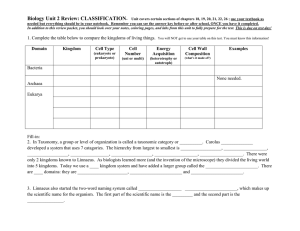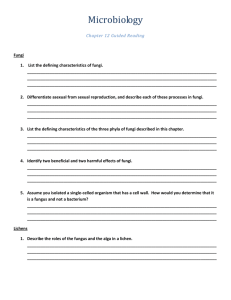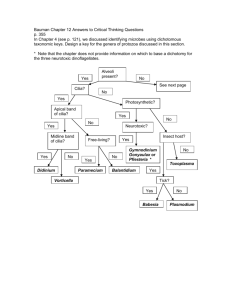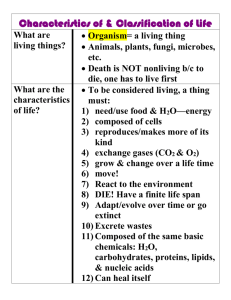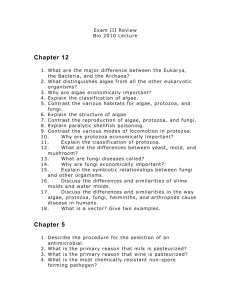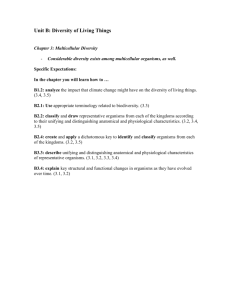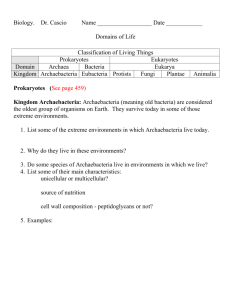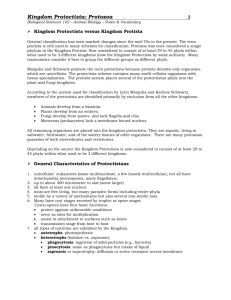Name the three kingdoms composed of eukaryotic microorganisms
advertisement
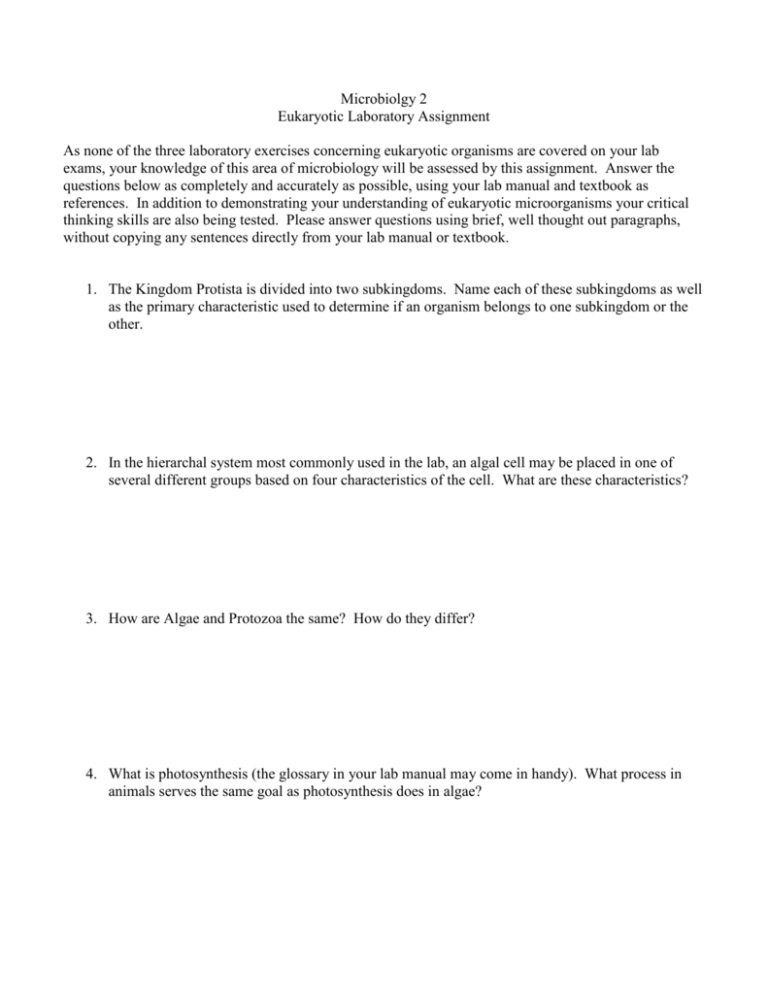
Microbiolgy 2 Eukaryotic Laboratory Assignment As none of the three laboratory exercises concerning eukaryotic organisms are covered on your lab exams, your knowledge of this area of microbiology will be assessed by this assignment. Answer the questions below as completely and accurately as possible, using your lab manual and textbook as references. In addition to demonstrating your understanding of eukaryotic microorganisms your critical thinking skills are also being tested. Please answer questions using brief, well thought out paragraphs, without copying any sentences directly from your lab manual or textbook. 1. The Kingdom Protista is divided into two subkingdoms. Name each of these subkingdoms as well as the primary characteristic used to determine if an organism belongs to one subkingdom or the other. 2. In the hierarchal system most commonly used in the lab, an algal cell may be placed in one of several different groups based on four characteristics of the cell. What are these characteristics? 3. How are Algae and Protozoa the same? How do they differ? 4. What is photosynthesis (the glossary in your lab manual may come in handy). What process in animals serves the same goal as photosynthesis does in algae? 5. Why are “red tides” red? Why are these tides seen at some times and not others? What algal division would be most likely to produce a “green tide”? 6. For each algal group seen below, place an “x” in the box if the characteristic indicated is present. Euglenozoa Chlorophyll a Chlorophyll b Chlorophyll c Fucoxanthin Xanthophylls Carotenes Phycocerythrin Phycocyanin Pellicle Flagella Cell wall Starch Paramylum Leucosin Oils Laminarian Mannitol Chlorophyta Rhodophyceae Alveolata Chrysophyceae Phaeophyceae Bacillariophyta 7. The number of cases of toxic seafood poisoning is far greater in the summer months, even taking into account that people are more likely to harvest seafood when the weather is warm. Why would illnesses due to ingestion of harmful algae be more prevalent in the summer? 8. The number and size of harmful algae blooms seems correlated to an increased use of fertilizers. Speculate on a possible connection between these two events. 9. In Hawaii, a test for the presence of ciguatoxin has been developed and is used to ensure the safety of game fish. Why is this same test not used in other areas of the world? 10. The subkingdom Protozoa is found within which Kingdom? What other subkingdom is found within this Kingdom? 11. What is the different between a trophozoite and a cyst? Which of these is generally more likely to cause an infection? Why is this? 12. Protozoans are classified as belonging to one of four different groups, based on a single characteristic. Please name the four groups and how this characteristic differs for each group. 13. For each of the four groups of protozoans covered in exercise 4, complete the table below by supplying the group, pathogen name and the body system or organ most likely to be infected? Protozoan group Pathogen Body system 14. What is the difference between a pseudopod, an amoeba, and amoeboid motion. 15. In the case in your lab book concerning Acanthomoeba keratitis (AK) infection among contact lens users, 46 culture confirmed cases were examined by the Centers for Disease Control. Of these cases, 42 occurred in persons wearing contact lenses while four cases occurred in non-lens wearers. How do people who do not wear contact lenses contract AK, and why does wearing lenses increase the rate of infection so dramatically. 16. Acanthamoeba is found as both a trophozoite and a cyst, but both forms seem to be equally effective at causing Acanthamoeba keratitis infections. In contrast, amebic dysentery is due almost exclusively to infection with the cyst form of Entamoeba histolytica, even though the organism can be found as both a trophozoite and a cyst. Why is this so? 17. Complete the table below. For each group found in the table, place an “x” in the box if the indicated structure or behavior is present. Flagellate Nucleus Cell membrane Motility seen in most members Are generally free living Are generally parasitic Move using flagella Move using cilia Move using pseudopods Are generally nonmotile Amoeba Ciliate Apicomplexan 18. Using the diagram below, provide the names, structures or descriptions for each of the lettered boxes. A) B) C) D) E) F) G) Fungi A Molds Psudohyphae B Spores C Septate E Asexual spores Sporangiospores D Zygospores F G 19. What single characteristic of fungi differentiate them from algae and plants? 20. How does the initial digestion of food in a fungus differ from the same process in an animal? 21. What is a mycosis? 22. What are the major characteristics used to differentiate: a. Fungi from plants: b. Fungi from animals: c. Fungi from protozoa: d. Deuteromycota from each of the other four fungal groups: e. The four major groups (Chytridiomycota, Zygomycota, Ascomycota, Basidiomycota) from one another? Classify the following organisms to the level asked for in the question (group, phyla, division, etc.) 23. You spot a small grayish-white growth on some raspberries. After isolating and testing a sample you find that the organism has an intact nucleus and cannot photosynthesize. Examination under the microscope reveals a fine hair-like organization ending in a fan-shaped structure. Closer examination reveals that the fan is made up of many long “sacs” each containing four to eight oval cells. a. Domain b. Kingdom c. Group 24. A single-celled organism found in a backyard pond is examined under the microscope. It is oval in shape, does not photosynthesize and is moving using the many tiny hair-like structures that cover the organism. a. Domain b. Kingdom c. Subkingdom d. Phylum 25. A sample of seawater contains a portion of a large organism (over 3m in length), brown in color, which stores food as mannitol. a. Domain b. Kingdom c. Subkingdom d. Phylum 26. The same sample contains several small organisms with nearly symmetrical shells. Further analysis indicates that the shells are made of silicon dioxide and that the organisms are rich in oil. a. Domain b. Kingdom c. Subkingdom d. Phylum: 27. Draw a phylogenetic tree linking fungi, algae and protozoa. Begin at the Domain level and continue to the level described in your lab manual (subgroup, division, group, etc.). Your textbook contains information about phylogenetic trees (pages 20-22) while figure 1.15 provides a good example of a phylogenetic tree linking the phyla of the Domain Bacteria to the phyla of the Domain Archaea. Remember, legibility is important for grading purposes, so be sure your final draft is neat and organized. Attach your final draft to this assignment when it is turned in.
